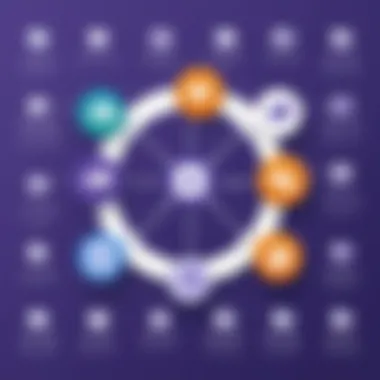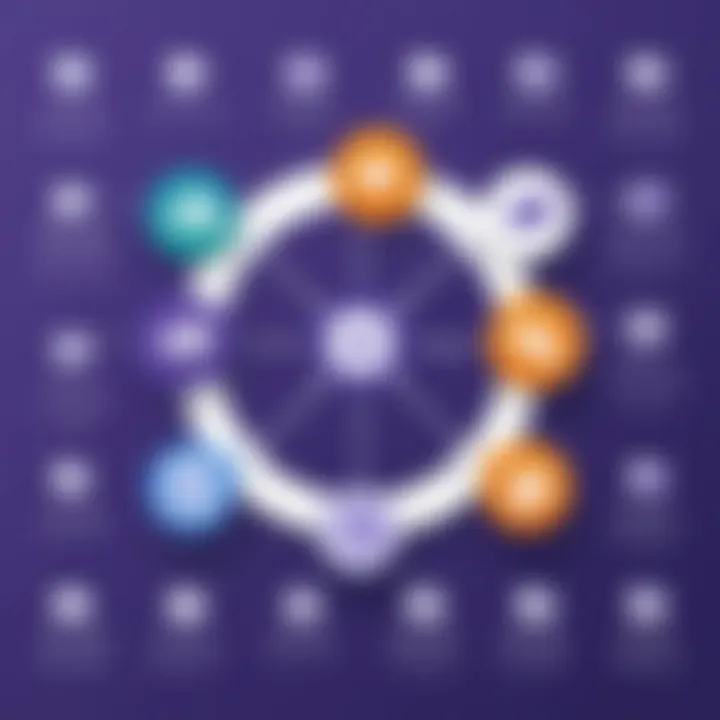Streamline Task Management with Microsoft Teams


Intro
Microsoft Teams has emerged as a pivotal platform for collaboration, especially in remote work settings. Task management is a critical feature within this tool. This article aims to provide insights into optimizing task management through Microsoft Teams, presenting its features, advantages, and practices that can lead to improved productivity for teams.
Overview of Software
Purpose and Use Cases
Microsoft Teams serves as a hub for teamwork and communication. Its task management capabilities are designed to help teams coordinate and prioritize their work effectively. Professionals from various sectors, including IT, project management, and education, can benefit from using Teams for task assignments, tracking progress, and facilitating discussions. Typical use cases involve team projects, client collaborations, and organizational planning.
Key Features
Microsoft Teams integrates several key features that enhance task management:
- Task Creation and Assignment: Users can create tasks directly within the Teams environment. This enables clear accountability as tasks can be assigned to specific team members.
- Integration with Planner and To Do: The seamless integration with Microsoft Planner and Microsoft To Do facilitates comprehensive task management. Team members can track their tasks in a centralized place.
- Real-Time Collaboration: Teams allows members to work on tasks simultaneously, with updates visible in real-time.
- Communication Tools: Built-in chat and video capabilities enable discussions around tasks, reducing the need for switching between applications.
- Task Status Tracking: Users can easily monitor progress through status updates, which provide insights into project timelines.
- Custom Views: Teams provides customizable views, such as Kanban boards, which can help visualize the progress and bottlenecks in task management.
In-Depth Review
Performance Analysis
After analyzing the performance of task management features in Microsoft Teams, it’s observed that they function smoothly for smaller teams. As team size and task volume increase, however, some users report performance lags during peak usages. Nevertheless, the integration with other Microsoft 365 services effectively mitigates these issues, allowing for a more cohesive workflow.
User Interface and Experience
Microsoft Teams offers an intuitive user interface. The navigation is straightforward, and team members can easily find their way around the task management features. The ability to integrate tasks with calendars and meetings provides a comprehensive overview of deadlines and obligations.
"A well-defined task management process promotes clarity and accountability within teams."
However, some users may find the amount of information displayed at once overwhelming, particularly on larger screens. It may take time for new users to familiarize themselves with all functionalities, particularly those who are not accustomed to Microsoft products. But this learning curve is often compensated by the long-term benefits of using a centralized platform for teamwork.
In summary, optimizing task management through Microsoft Teams involves understanding its purpose, utilizing key features effectively, and adapting to its user interface for enhanced collaboration. This analysis lays the groundwork for exploring best practices and additional strategies that can further enhance productivity.
Preface to Microsoft Teams
In contmporary work environments, the role of collaboration tools cannot be understated. Microsoft Teams emerges as a pivotal player in optimizing task management within organizations. This section serves to introduce Teams and the implications it has for efficent task management.
Its feature set includes advanced functionality for task assignment, tracking, and, importantly, integration with other Microsoft services like Planner and To Do. This integration capability enhances the user experience, facilitating a streamlined workflow that aids in managing responsibilities effectively.
Additionally, Teams fosters communication and ensures that all members are aware of their tasks. The importance of clearly defined tasks cannot be overlooked; they directly impact productivity and efficient workflow.
Overview of Microsoft Teams
Microsoft Teams is a collaboration platform that combines workplace chat, video meetings, file storage, and application integration. Launched in 2017, it has evolved into a comprehensive suite for team collaboration. Teams is not just a communication tool; it offers a shared workspace where documents can be edited collectively in real-time.
The interfaces are designed to be user-friendly. Teams allows users to create channels dedicated to specific projects or subjects. Within these channels, members can share files, hold discussions, and manage tasks. This setup creates an organized structure that enhances transparency within teams. One of the crucial elements of Teams is its ability to integrate with various Microsoft applications, making it a powerful hub for collaboration.
The Importance of Task Management
Effective task management is critical for any successful project. It ensures that team members are aligned with their responsibilities and deadlines. Within Microsoft Teams, task management features enable users to assign, prioritize, and supervise tasks seamlessly. This prevents misunderstandings and miscommunications, which can derail even the most well-planned projects.
Moreover, a structured task management system promotes accountability. When tasks are assigned clearly, team members understand what is expected from them. Regular updates on task status help to maintain momentum and keep everyone on the same page. In essence, optimizing task management within Microsoft Teams transforms not only individual productivity but also collective team performance.
"Task management is about more than tracking duties. It’s about facilitating collaboration and ensuring that tasks lead to actionable outcomes."
Task Management Features in Microsoft Teams
Task management is a critical component in achieving team efficiency and productivity. With Microsoft Teams, organizations leverage a platform that provides robust task management features suitable for diverse work environments. The importance of these features lies in their ability to streamline workflows, ensure accountability, and enhance collaboration. Teams can better manage projects, allocate tasks effectively, and reduce the chances of miscommunication.
Task Assignment and Tracking
The process of task assignment and tracking within Microsoft Teams is efficient and user-friendly. Managers can assign tasks directly within the app, allowing team members to receive notifications about their responsibilities. Each task can have a clear deadline and description, ensuring that members understand what is expected of them. The task tracking feature is integrated seamlessly with Planner and To Do apps, which provide visual boards and lists to monitor progress. Team leaders can check the status of tasks in real-time, facilitating quick adjustments or support if needed. This transparency helps teams stay aligned and focused on collective goals.
Integration with Planner and To Do
Integration with Microsoft Planner and To Do is one of the standout features for task management in Teams. With Planner, teams can create visual task boards that reflect ongoing projects. Each task can be categorized, labeled, and even prioritized according to urgency. This setup allows team members to have a clear visual representation of their workloads.
On the other hand, To Do enables users to manage their personal tasks alongside shared team tasks. Individuals can customize their to-do lists, get reminders, and set priorities. This dual integration means that personal and team responsibilities can coexist without overlap. It also promotes a productive mindset, as individuals can focus on both their tasks and their contributions to the overall team objectives.


Customization of Task Lists
Customization of task lists in Microsoft Teams provides an added layer of flexibility. Users can modify task parameters to fit their specific needs. For instance, team leaders can create task lists by various projects or departments. Additionally, tasks can be tagged with various labels such as "urgent," "in progress," or "completed." This allows members to filter through tasks quickly based on their criteria.
Moreover, the ability to assign different team members to specific tasks means responsibilities can be distributed according to individual strengths and availability. This tailored approach ensures that tasks align with the right skill sets, thereby enhancing the productivity and satisfaction of team members.
"Using Microsoft Teams for task management transforms how teams collaborate and track their work effectively."
Creating a Task Management Framework
Creating a structured framework for task management within Microsoft Teams is essential. This framework serves not just as a guideline but establishes a solid foundation for collaboration and productivity. When teams define their roles, set objectives, and communicate effectively, they enhance their ability to meet deadlines and achieve goals affirmatively. A task management framework is beneficial in aligning the team’s focus and streamlining processes.
Defining Team Roles and Responsibilities
Defining roles within a team is crucial for clarity. Each member should understand their unique contributions to the project. This prevents overlap and reduces confusion. A well-defined role allows individuals to take ownership of their tasks, resulting in higher accountability. It’s helpful to list all roles and responsibilities explicitly within Teams, preferably in a dedicated channel. This approach can guide team members and clarify who is responsible for specific tasks.
- Clarity: Clear roles reduce confusion and ensure efficiency.
- Ownership: Defined responsibilities promote accountability.
- Collaboration: Understanding roles aids in fostering collaboration among team members.
Setting Clear Objectives and Deadlines
Setting explicit objectives and deadlines is a fundamental aspect of any task management framework. Objectives give direction to the team, while deadlines create a sense of urgency. Both should be Specific, Measurable, Achievable, Relevant, and Time-bound (SMART). This clarity ensures that everyone works towards common goals. Goals should be visible, possibly pinned in a Teams channel or documented in a shared file.
- Define Clear Objectives: Create goals that align with team expectations.
- Develop a Timeline: Attach realistic deadlines to each objective.
- Review Progress: Regularly assess the attainment of goals while allowing room for adjustment if necessary.
Establishing Communication Protocols
Effective communication is at the heart of successful task management. Establishing norms on how and when updates should occur is vital. Teams should agree on the preferred channels for communication, whether it be chat, video calls, or forums within Teams. Additionally, regular check-ins can keep everyone aligned.
- Select Channels: Choose appropriate platforms for different types of communication.
- Frequency: Determine how often team members should communicate updates related to their tasks.
- Feedback Loops: Create structured opportunities for feedback to optimize task handling.
Effective communication is key to the success of any team environment. Without it, clarity and cohesion suffer.
Collaboration Tools within Microsoft Teams
The role of collaboration tools in Microsoft Teams cannot be understated. These tools are essential for facilitating effective communication and teamwork within the platform. With increasing demands for remote work, the importance of seamless collaboration grows. Teams provides various features that enable members to work together more efficiently, eliminating barriers caused by distance and time zones.
With a well-integrated set of features, Microsoft Teams allows users to shift from traditional communication to real-time digital interactions. This transition is vital for enhancing productivity and ensuring everyone involved stays aligned with team objectives. When team members can share ideas, updates, and feedback instantly, it leads to faster decision making and project progression.
Real-Time Communication Features
Real-time communication is at the heart of Microsoft Teams. This feature allows users to engage in instant messaging, video calls, and audio conversations without the need to switch to different applications. Having a single platform for all these interactions saves time and simplifies the workflow.
Messaging in Teams is not limited to one-on-one conversations; it supports group chats as well. This flexibility enables team members to brainstorm, share insights, and discuss relevant topics without scheduling formal meetings. Furthermore, mentioning colleagues in conversations with the @ symbol keeps everyone informed and engaged.
Additionally, video conferencing is a crucial aspect of real-time communication. It provides a more personal touch, allowing facial expressions and body language to be part of the conversation. This aspect enhances understanding and fosters stronger relationships among team members. Conducting meetings via Teams also allows for screen sharing, making it easier to present ideas or explain complex issues visually.
File Sharing and Document Collaboration
File sharing and document collaboration are significant aspects of task management in Microsoft Teams. Users can upload files directly into the chat or within a dedicated channel, which promotes easy access and organization. This feature eliminates the confusion often associated with version control, as all team members can access the most current document.
Microsoft Teams seamlessly integrates with SharePoint and OneDrive. This integration means that files can be edited in real time by multiple users, allowing for collaborative document editing. As changes are made, everyone involved sees these updates instantly, which reduces redundant communication and keeps everyone on the same page.
In terms of security, file sharing through Teams maintains compliance with the organization's policies, ensuring sensitive information remains protected. The ability to set permissions for who can view or edit documents adds an extra layer of security, which is especially vital for businesses handling confidential data.
Overall, the collaboration tools within Microsoft Teams are designed not just for communication, but for enhancing teamwork and productivity. The integration of real-time features and efficient document management creates an environment where teams can thrive.
With all these tools, organizations can leverage Microsoft Teams to optimize their task management capabilities, ensuring that team members are empowered to deliver their best work.
Best Practices for Effective Task Management
Effective task management is crucial for maximizing productivity within teams. When teams make use of Microsoft Teams, they should implement best practices that not only streamline processes but also foster an efficient working environment. These practices ensure that team members are aligned, accountable, and engaged with their tasks. The following subsections detail specific strategies for optimizing task management.
Utilizing Tags and Filters
Tags and filters in Microsoft Teams can significantly enhance the visibility and accessibility of tasks. By categorizing tasks with descriptive tags, team members can quickly locate important items in a list. Tags might include priority levels, types of work, or related projects. This organization allows individuals to focus on what's most critical without sifting through irrelevant information.
To apply this effectively, consider the following steps:


- Identify key categories relevant to your projects.
- Create a tagging system that is easy to understand and follow.
Benefits of using tags and filters include:
- Improved organization: Quickly finding tasks reduces wasted time.
- Enhanced focus: Team members can concentrate on urgent items without distraction.
Regular Updates and Status Meetings
Frequent updates and status meetings are essential practices in maintaining the flow of task management. These meetings should provide opportunities for team members to report on progress and address any obstacles. Regular communication helps ensure that everyone is on the same page and working toward the same objectives.
When planning these updates, remember to:
- Schedule meetings at consistent intervals.
- Encourage team members to prepare brief reports on their tasks prior to meetings.
Keeping everyone aligned can lead to several advantages:
- Increased accountability: Team members take ownership of their assigned tasks.
- Early problem detection: Challenges can be identified and addressed quickly.
Feedback Mechanisms for Continuous Improvement
Feedback is a cornerstone of effective task management. Establishing mechanisms for gathering input from team members allows for evaluation and adaptation of processes. Constructive feedback fosters a culture of openness and learning within the team. Moreover, it enables teams to recognize patterns that may indicate areas for improvement in task management.
To implement feedback mechanisms, consider the following practices:
- Create anonymous surveys to gather honest opinions on processes and tools.
- Schedule periodic one-on-one check-ins or small group discussions.
Using feedback effectively leads to:
- Enhanced team dynamics: Open discussions can strengthen rapport among team members.
- Ongoing adaptation: Teams can make informed adjustments to workflows based on practical input.
Consistently applying these best practices in Microsoft Teams can ultimately lead to a more organized, productive, and engaged team environment.
Challenges in Task Management with Microsoft Teams
Task management can seem straightforward, but when using a comprehensive platform like Microsoft Teams, various challenges can arise. Understanding these challenges is vital, especially for professionals aiming to optimize their workflows and enhance productivity. The effectiveness of task management hinges on how well the tool integrates into existing processes, supports user needs, and adapts to change.
Technical Limitations and Issues
Despite its robustness, Microsoft Teams has limitations that can hinder task management. One common issue is the integration of tasks across different apps. While Microsoft Teams offers integration with tools like Planner and To Do, some users experience synchronization problems. These issues can lead to conflicting information and confusion about task status.
Another technical hurdle is the user interface. Although Teams aims to be user-friendly, the abundance of features can overwhelm new users. Navigating through channels and tabs can be confusing, especially when trying to locate specific tasks or updates. Lack of an intuitive design can result in a steep learning curve.
Finally, some users may experience performance issues, especially in large teams with abundant data and ongoing projects. Lagging response times or crashes can disrupt seamless collaboration, leading to frustration and inefficiency among team members.
User Resistance and Training Needs
The success of adopting Microsoft Teams for task management largely depends on user acceptance. Sometimes, team members may be resistant to transitioning to new tools. They may feel comfortable with their previous task management systems and perceive Microsoft Teams as complex or unnecessary.
Training becomes a critical element to overcoming this resistance. Ensuring all users have a clear understanding of the platform is essential. Organizations must invest in training sessions and create resource materials that demystify the tool. Familiarity with features such as task assignment, deadlines, and tracking will encourage user engagement.
Regular follow-ups can also be beneficial. This approach provides an opportunity for users to ask questions and address concerns regarding the platform. Recognizing that Microsoft Teams may initially be challenging for many encourages a culture of support and confidence.
"Training employees on new task management tools is not just an option; it is a necessity for successful implementation and team cohesion."
In summary, the challenges in task management using Microsoft Teams encompass technical limitations and user resistance. Addressing these obstacles directly can lead to a more productive and collaborative environment.
Leveraging Third-Party Integrations
Integrating third-party tools with Microsoft Teams offers significant advantages for optimizing task management. These integrations extend the built-in capabilities of Teams, allowing for a more customized workflow that caters to specific team needs. By leveraging external applications, organizations can enhance collaboration, automate processes, and improve productivity. It is crucial to assess how these add-ons can fit into existing systems and overall team dynamics.
Available Add-Ons for Enhanced Functionality
Numerous third-party applications can be integrated with Microsoft Teams to elevate task management effectiveness. Some popular add-ons include:
- Trello: A visual project management tool that allows teams to organize tasks using boards and cards. Integration helps keep track of projects directly from Teams.
- Asana: This task management software provides visibility into the progress of projects. Users can create, assign, and track tasks without leaving the Teams environment.
- Zapier: By connecting Microsoft Teams with hundreds of apps, Zapier allows for automation. It helps streamline workflows by integrating various tools that the team already uses.
- Slack: Although primarily a communication tool, Slack's integration with Teams can help streamline notifications and updates, keeping everyone informed.
Using these add-ons can help fill in gaps left by Teams' native features. They can allow for more advanced tracking, reporting, and collaboration possibilities.


Choosing the Right Tools for Your Team
Selecting the appropriate third-party integrations is key to achieving effective task management. Consideration should be given to the specific needs of your team. Here are some factors to consider:
- Compatibility: Ensure that the tool works seamlessly with existing Microsoft Teams features. Movement between applications should be smooth.
- Usability: A user-friendly interface ensures that all team members can adopt the tool without a steep learning curve.
- Customizability: Pick tools that allow settings and features to be tailored to the team's workflows. This ensures they can adapt as needs evolve.
- Support and Reliability: Choose applications with good customer support and track records for reliability. High uptime and responsive assistance contribute to effective task management.
"The right integrations can propel a team's performance, driving not just productivity but also engagement and satisfaction."
Evaluating the Impact of Microsoft Teams on Task Management
Evaluating the impact of Microsoft Teams on task management is crucial for organizations seeking to optimize their workflows. Understanding how this platform influences productivity, communication, and overall efficiency enables teams to harness its full potential. This evaluation also helps in identifying benefits, potential pitfalls, and the real value added to team dynamics.
Measuring Productivity Gains
Measuring productivity gains is a vital part of assessing how Microsoft Teams enhances task management. Productivity can be influenced by various factors such as time spent on tasks versus results achieved. With the integration of tools like Planner and To Do, tracking progress becomes straightforward.
- Task Completion Rates: Examining how quickly tasks are completed after implementing Teams is one indicator of productivity.
- Efficiency Metrics: Look at metrics like average time spent on task management versus output quality.
- Collaboration Impact: Determine if the ability to communicate in real-time within Teams shortens the project life cycle.
Using features like @mentions and direct links to tasks can drive engagement and prioritization of workloads. Tracking these can lead to actionable insights.
Assessing Team Satisfaction and Engagement
Engagement is another critical aspect to consider. Team satisfaction can directly affect the success of task management efforts. High levels of engagement typically correlate with better outcomes. Factors to evaluate include:
- User Adoption: Is the team using Teams regularly? High usage often indicates satisfaction with the tool.
- Feedback Mechanisms: Collecting feedback about the Teams experience can uncover areas for improvement and contribute to higher morale.
- Communication Clarity: Clear communication through Teams can increase satisfaction levels. Assess whether team members feel they can express their ideas freely.
"Regular assessments of team satisfaction provide invaluable feedback for refining task management processes."
Utilizing surveys and open discussions can gauge how well the platform is serving the team's needs. Consistently revisiting these areas helps maintain a productive task management environment.
Future of Task Management in Microsoft Teams
Understanding the future of task management within Microsoft Teams is crucial. As more organizations rely on remote collaboration, teams seek tools that not only facilitate communication but also enhance productivity. Microsoft Teams has been evolving to meet these needs, integrating various features aimed at streamlining task management processes.
By focusing on task management within Teams, we can appreciate its potential to shape performance benchmarks and workflows. Companies can align their operations and ensure that deadlines are met efficiently. Moreover, the prospect of updates and improvements within the platform indicates a commitment to continually adapt to users' needs.
Anticipated Features and Updates
Microsoft has announced several anticipated features set to enhance task management capabilities in Teams. These updates focus on increased functionality and user-friendly interfaces.
Key anticipated features include:
- Enhanced Integration with other Microsoft 365 applications. This will ensure seamless transitions between tools like OneNote and Outlook, improving task accessibility.
- Improved AI Capabilities to automate repetitive tasks and provide intelligent suggestions based on user activities. This can significantly reduce the manual effort involved in task management.
- Customizable Dashboards that allow teams to visualize their progress and tailor the information displayed. Customization can influence the efficiency with which teams can assess their workload.
These enhancements reflect a broader industry trend towards personalized workspace solutions and task automation. The combination of these features could fundamentally change how organizations view and utilize task management systems.
Emerging Trends in Team Collaboration
The landscape of team collaboration is shifting, influenced by factors such as remote work and advances in technology. Microsoft Teams is adapting to these trends by introducing features that support both synchronous and asynchronous collaboration.
Some emerging trends include:
- Increased Demand for Flexibility in how teams interact and manage tasks. More workers expect accessibility across devices, ensuring that work can continue unhindered, regardless of location.
- Focus on Well-being which considers work-life balance. Tools that manage tasks while promoting a healthy workflow will likely gain traction and relevance.
- AI-Powered Collaboration which monitors user behaviors and proposes optimizations for teamwork. The idea is to remove barriers that lead to inefficient practices.
As these trends envelop the workplace, tools like Microsoft Teams position themselves as essential solutions. They will be attributed with facilitating collaboration effectively while ensuring that tasks are not only managed but also aligned with team values and strategies.
"The ongoing transformation in task management reflects a commitment to continual improvement, ensuring teams can adapt to changing dynamics seamlessly."
The combination of anticipated features and these emerging trends suggests that the future of task management in Microsoft Teams is bright. Leveraging these insights can provide organizations with a competitive edge, making task management not just a function, but a strategic advantage.
End
Summarizing Key Insights
In reviewing the comprehensive discussion on Microsoft Teams, several critical insights emerge. First, Microsoft Teams is not just a mere communication tool; its robust task management features facilitate collaboration in ways that enhance overall productivity. The integration with tools like Planner and To Do simplifies the tracking and assignment of tasks. These integrations allow teams to streamline their workflow efficiently, making task management not just effective but also intuitive.
Additionally, defining roles and responsibilities within teams helps clarify expectations. Setting clear objectives and deadlines further fortifies this framework. Regular updates and feedback mechanisms create a culture of continuous improvement. These practices not only optimize workflows but also keep team members engaged and aligned with project goals.
Final Thoughts on Task Management Effectiveness
Task management within Microsoft Teams can significantly leverage the efficiency of a team's operations when done right. It encourages a structured approach to tasks, minimizes confusion, and fosters collaboration. As software developers and IT professionals continue to seek ways to enhance their productivity, embracing Microsoft Teams for task management presents an array of advantages.
While there are challenges, such as technical limitations and the need for user training, these can often be mitigated with proper planning and support. Therefore, the effectiveness of task management in this platform cannot be overstated. By harnessing its capabilities, teams can achieve more within their projects, resulting in improved performance and satisfaction.
"Effective task management requires not only the right tools but a cultural shift towards collaboration."
In summary, implementing the best practices discussed in this article leads to a more organized and productive working environment, ensuring that teams not only meet their objectives but exceed expectations.







